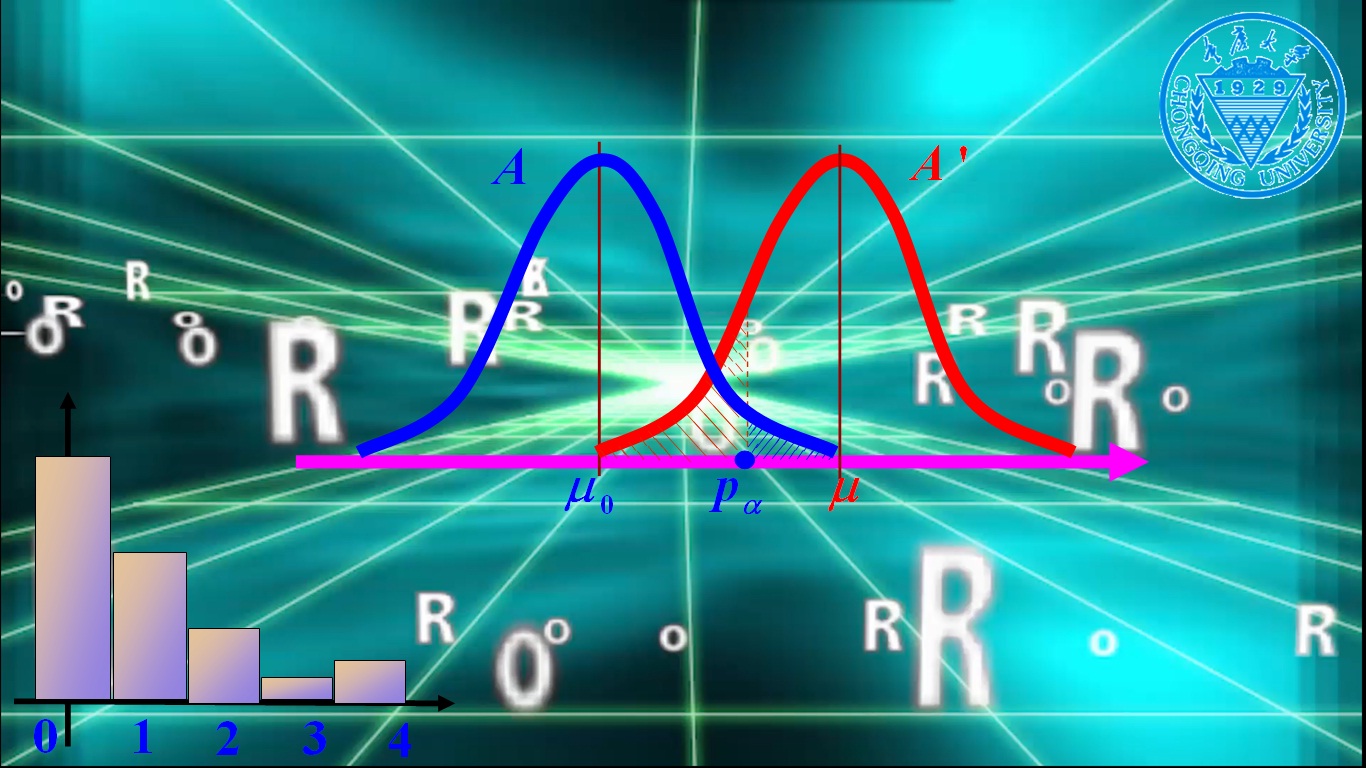
当前课程知识点:C Programming > Chapter 8 Pointer > 8.1 Pointer Concept, Definition and Reference of Pointer Variables > 8.1 Pointer Concept, Definition and Reference of Pointer Variables.mp4
大家好,我是云南大学信息学院丁海燕老师
欢迎走进C语言程序设计课堂
今天我们讲解指针概念、指针变量的定义和引用
指针是什么?
如果在程序中定义了一个变量
在对程序进行编译时,系统就会给该变量分配
内存单元编译系统根据程序中定义的变量类型
分配一定长度的空间
例如,VC++为整型变量分配4个字节
对单精度浮点型变量分配4个字节
对字符型变量分配1个字节
内存区的每一个字节有一个编号,这就是“地址”
它相当于旅馆中的房间号。
在地址所标识的内存单元中存放数据
这相当于旅馆房间中居住的旅客一样。
由于通过地址能找到所需的变量单元
我们可以说,地址指向该变量单元。
将地址形象化地称为“指针”
务必弄清楚存储单元的地址和存储单元的内容
这两个概念的区别,例如:
int i=3,j=6,k;
printf(“%d”,i);
假设程序已定义了3整型变量i,j,k
程序编译时,可能分配地址2000~2003的
4个字节给变量i,2004~2008的4个字节给变量j
2008~2011的4个字节给k.如图所示.
程序中一般是通过变量名来引用变量的值
实际上,是通过变量名i,找到i的存储单元的地址2000
从而从存储单元读取3。
程序经过编译以后,已经将变量名转换为变量的地址
对变量值的存取都是通过地址进行的
若有语句k=i+j;
则从2000~2003字节取出i的值3
再从2004~2007字节取出j的值6
将它们相加后再将其和9送到
k所占用的2008~2011字节单元中。
这种直接按变量名进行的访问
称为“直接存取(访问)”方式。
还可以采用另一种称之为“间接访问”的方式
即将变量i的地址存放在另一变量中
然后通过该变量来找到变量i的地址,从而访问i变量。
在C语言中,可以定义整型变量、实型变量
字符变量等,也可以定义这样一种特殊的变量,用它存放地址。
假设定义了一个变量i_pointer
用来存放整型变量的地址,可以通过下面语句
将i的地址(2000)存放到i_pointer中。
i_pointer=&i;
这时,i_pointer的值就是2000
(即变量i所占用单元的起始地址)
要存取变量i的值,既可以用直接访问的方式
也可以采用间接访问的方式
先找到存放“变量i的地址”的变量i_pointer
从中取出i的地址(2000),然后到2000字节开始的
存储单元中取出i的值(3),如图所示。
图a表示直接访问,根据变量名直接向变量i赋值
由于变量名与变量的地址有一一对应的关系
因此就按此地址直接对变量i的存储单元进行访问。
图b表示间接访问,先找到存放变量i的地址的变量
i_pointer,从中得到变量i的地址(2000)
从而找到变量i的存储单元,然后对它进行存取访问。
•为了表示将数值3送到变量中,可以有两种表达方法:
(1) 将3直接送到变量i所标识的单元中,例如:i=3;
(2) 将3送到变量i_pointer所指向的单元
(即变量i的存储单元)
例如:*i_pointer=3; 其中*i_pointer表示i_pointer指向的对象
•指向就是通过地址来体现的
–假设i_pointer中的值是变量i的地址(2000)
–这样就在i_pointer和变量i之间建立起一种联系
即通过i_pointer能知道i的地址
从而找到变量i的内存单元
由于通过地址能找到所需的变量单元
因此说,地址指向该变量单元
将地址形象化地称为“指针”
意思是通过它能找到以它为地址的内存单元
•一个变量的地址称为该变量的“指针”
例如,地址2000是变量i的指针
如果有一个变量专门用来存放另一变量的地址
(即指针),则它称为“指针变量”
i_pointer就是一个指针变量
指针变量就是地址变量,用来存放地址的变量
指針变量的值是地址(即指针)
“指针”和“指针变量”是不同的概念
可以说变量i的指针是2000,而不能说i的指针变量是2000
指针是一个地址,而指针变量是存放地址的变量
从上节已知,存放地址的变量是指针变量
它用来指向另一个对象(如变量、数组、函数等)
那么怎样定义和使用指针变量呢?
下面来看,例8.1 通过指针变量访问整型变量
解题思路:先定义2个整型变量
再定义2个指针变量,分别指向这两个整型变量
通过访问指针变量,可以找到它们所指向的变量
从而得到这些变量的值
程序如下
{ int a=100,b=10;
int *pointer_1, *pointer_2; //定义两个指针变量
pointer_1=&a; //使pointer_1指向a
pointer_2=&b; //使pointer_2指向b
用printf(“a=%d,b=%d ”,a,b); //直接输出变量a和b的值
用printf输出*pointer_1和*pointer_2的值
这是间接输出变量a和b的值
int *pointer_1, *pointer_2;
此处*与类型名在一起
此时共同定义指针变量
printf(“*pointer_1=%d,*pointer_2=%d ”
此处*与指针变量一起使用
此时代表指针变量所指向的变量
定义指针变量的一般形式为:
类型名 * 指针变量名;
如:int *pointer_1, *pointer_2;
int是为指针变量指定的“基类型”
基类型指定指针变量可指向的变量类型
如pointer_1可以指向整型变量
但不能指向浮点型变量
下面都是合法的定义和初始化:
但是pointer_3=2000; 错误
*pointer_1=&a; 错误
pointer_1=&a; 正确
pointer_3=&a; 错误
定义指针变量时要注意:
1.指针变量前面的”*”表示该变量的类型为指针型变量。
2.在定义指针变量时必须指定基类型。
3.如何表示指针类型
指向整型数据的指针类型表示为int *,
读作“指向int的指针”或简称”int指针”
4. 指针变量中只能存放地址,即指针
不要将一个整数赋给一个指针变量,如
*pointer_1=100;错误
在引用指针变量时,可能有三种情况:
给指针变量赋值,如:p=&a; 使p指向a
引用指针变量指向的变量,例如
p=&a; *p=1; (*p相当于a)
则执行printf(“%d”,*p); 将输出1
引用指针变量的值,如:printf(“%o”,p);
以八进制输出a的地址
要熟练掌握两个有关的运算符
(1) & 取地址运算符
&a是变量a的地址
(2) * 指针运算符或“间接访问”运算符
如果: p指向变量a,则*p就代表a
k=*p; (把a的值赋给k)
*p=1; (把1赋给a)
下面来看,例8.2 输入a和b两个整数
按先大后小的顺序输出a和b
解题思路:用指针方法来处理这个问题
不交换整型变量的值,而是交换两个指针变量的值
程序如下:
{ int *p1,*p2,*p,a,b; p1,p2的类型是int *
输入两个整数
使p1指向a,使p2指向b
如果a小于b
则交换p1与p2的值
输出a,b
输出p1和p2所指向的变量的值
{ p=p1; p1=p2; p2=p; } 交换p1与p2的值
printf(“a=%d,b=%d ”,a,b); 输出a,b的值
printf(“%d,%d ”,*p1,*p2); 输出p1和p2所指向的变量的值9和5
下面来思考 { p=p1; p1=p2; p2=p; } 可否改为p1=&b; p2=&a;
注意:
a和b的值并未交换,它们仍保持原值
但p1和p2的值改变了,p1的值原为&a
后来变成&b,p2原值为&b,后来变成&a
这样在输出*p1和*p2时,实际上是
输出变量b和a的值,所以先输出9,然后输出5
好了,同学们,指针的概念、指针变量的定义
和引用我们就学习到这儿,下节课再见!
-1.1 The development and characteristics of C language
--1.The development and characteristics of C language .mp4
--1.1 Self test questions
-1.2 A simple C Language program
--1.2 A simple C Language program.mp4
--【Source program】 Example 1.1 output a line of text Hello, world! "
--【Source program】 Example 1.2 program composed of multiple functions, find the larger of two integers
--1.2 Self test questions
-1.3 Program, Programming Language and C Program Running Steps
--1.3 Program, Programming Language and C Program Running Steps.mp4
--Running steps of C source program in CodeBlocks
--1.3 Self test questions
-chapter 1 Self-Test
-2.1 The Concept and Description of Algorithms
--2.1 The Concept and Description of Algorithms.mp4
--2.1 Self test questions
-2.2 Examples of Simple Algorithms, Computational Thinking and Structured Programming
--2.2 Examples of Simple Algorithms, Computational Thinking and Structured Programming.mp4
--2.2 Self test questions
-Chapter 2 Self test questions
-3.1 Simple Structure and Identifier of C Language Program
--3.1 Simple Structure and Identifier of C Language Program.mp4
--【Source program】 Example 3.1 input two integers and output the sum of two numbers.
--【Source program】 Example 3.2 input two integers and output the average value.
--【Source program】 Example 3.3 output the value of the character variable.
--3.1 Self test questions
-3.2 Constants, Variables and Assignments
--3.2 Constants, Variables and Assignments.mp4
--3.2 Self test questions
-3.3 Arithmetic, assignment, increment and decrement operators
--3.3 Arithmetic, assignment, increment and decrement operators.mp4
--3.3 Self test questions
-3.4 Conditions, commas, addresses, byte operators, and mixed operations among various numerical data
--3.4 Conditions, commas, addresses, byte operators, and mixed operations among various numerical data
--【Source program】 example of sizeof
--3.4 Self test questions
-3.5 Input and Output Examples and Character Input and Output
--3.5 Input and Output Examples and Character Input and Output.mp4
--【Source program】 Example. Find the root of quadratic equation of one variable.
--【Source program】 Example 1. Successively output three characters of BOY.
--【Source program】Example 2. Input 3 characters of BOY from the keyboard and output them to the screen
--3.5 Self test questions
-3.6 Formatted output printf function
--3.6 Formatted output printf function.mp4
--【Source program】 Example 3.4 output of integer data.
--【Source program】 Example 3.5 real data output.
--【Source program】 Example 3.6 character data output.
--【Source program】 Example 3.7 uses %s to output a string.
--3.6 Self test questions
-3.7 Formatted input scanf function
--3.7 Formatted input scanf function.mp4
--【Source program】 Example 3.8 Input and output integer data
--【Source program】Example 3.9 Input and output single precision and double precision real data.
--【Source program】Example 3.10 input and output character data.
--【Source program】Example 3.11 input and output string.
--3.7 Self test questions
-3.8 Basic Data Types of C Language
--3.8 Basic Data Types of C Language.mp4
--3.8 Self test questions
-Chapter 3 Self test questions
-Operator and expression self test questions
-4.1 Relational operators, logical operators, and if statements
--4.1 Relational operators, logical operators, and if statements.mp4
--【source example】Example 4.1 Find the root of the quadratic equation of one variable.
--【Source program】Example 4.2 Input two real numbers and output them from small to large.
--4.1 Self test questions
-4.2 Switch Statement
--【Source program】Example 4.3 uses switch statement to implement simple menu program
--【Source program】Example 4.4 converts centesimal score into the corresponding grade system score.
--4.2 Self test questions
-4.3 Examples of Selection Structural Programs
--4.3 Examples of Selection Structural Programs.mp4
--【Source program】 Example 4.5 determines whether a year is a leap year.
--【Source program】 Example 4.6 find the solution of quadratic equation of one variable.
--【Source program】Example 4.7 calculate the transportation cost for the user.
--4.3 Self test questions
-Chapter 4 Self test questions
-5.1 While and Do-While Statement
--5.1 While and Do…while statement.mp4
--【Source program】example 5.1 Use while statement to find 1 + 2 + 3 + +100
--【Source program】example 5.2 using do while statement to find 1 + 2 + 3 + +100
--5.1 Self test questions
-5.2 For Statement
--【Source program】example 5.3 Use for loop to find 1 + 2 + 3 +100
--5.2 Self test questions
-5.3 Change the State of Loop Execution and Nested Loop
--5.3 Change the state of loop execution and nested loop .mp4
--【Source program】example 5.4 collecting charity donations
--【Source program】example 5.5 output a number between 100 and 200 that cannot be divided by 3.
--【Source program】multiplication table
--【Source program】example 5.6 Output the following 4*5 matrix.
--5.3 Self test questions
-5.4 Loop Structure Program example 1
--5.4 Loop structure program example 1.mp4
--5.4 Self test questions
-5.5 Loop Structure Program example 2
--5.5 Loop structure program example 2.mp4
--【Source program】example 5. Output the following figure.
--【Source program】example6. The problem of 100 chickens and 100 coins
--【Source program】example 7. Find the approximate value of PI
--5.5 Self test questions
-Chapter 5 Self test questions
-6.1 Definition, Reference and Initialization of One-Dimensional Arrays
--6.1 Definition, Reference of One-Dimensional Arrays.mp4
--6.1 Self test questions
-6.2 One-Dimensional Array Programming
--6.2 One-Dimensional Array Programming.mp4
--【Source program】example 1. Fibonacci sequence
--【Source program】example 2. Find the maximum value and the minimum value.
--【Source program】example 3 exchanging array elements in reverse order.
--【Source program】example 4. Bubble sorting.
--6.2 Self test questions
-6.3 Definition, Reference and Initialization of Two-Dimensional Arrays
--6.3 Definition, Reference of Two-Dimensional Arrays.mp4
--6.3 Self test questions
-6.4 Two-Dimensional Array Programming
--6.4 Two-Dimensional Array Programming.mp4
--【Source program】example 1. Get the average score of each subject.
--【Source program】Example 2. The elements of row and column of a 2D array are interchanged
--6.4 Self test questions
-6.5 Definition, initialization and input and output of character arrays
--6.5 Definition, initialization and input and output of character arrays .mp4
--【Source program】Example 6.6 Output a known string.
--【Source program】Example 6.7 Output a diamond.
--【Source program】Example 6.10 Sorting of strings.
--6.5 Self test questions
-6.6 String Processing Function
--6.6 String Processing Function.mp4
--6.6 Self test questions
-6.7 Character Array Programming
--6.7 Character Array Programming.mp4
--6.7 Self test questions
-Chapter 6 Self test questions
-7.1 Function Concept and How to Define and Call Functions
--7.1 Function Concept and How to Define and Call Functions.mp4
--7.1 Self test questions
-7.2 Data Transfer in Function Call, Call Procedure and Function Return Value
--7.2 Data Transfer in Function Call, Call Procedure and Function Return Value.mp4
--7.2 Self test questions
-7.3 Declarations of called functions and nested calls to functions
--7.3 Declarations of called functions and nested calls to functions .mp4
--【Source program】Example 7.4 use a function to find the sum of t
--7.3 Self test questions
-7.4 Recursive call to function
--7.4 Recursive call to function.mp4
--【Source program】Example 7.6. How old is the fifth student?
--【Source program】Example 7.7 Use recursion method to find n!
--7.4 Self test questions
-7.5 Array as function parameter (1)
--7.5 Array as function parameter (1).mp4
--【Source program】Example 7.10
--7.5 Self test questions
-7.6 Array as function parameter (2)
--7.6 Array as function parameter (2).mp4
--【Source program】Selection sorting.
--【Source program】Example 7.13 find the maximum of a 3×4 matrix.
--7.6 Self test questions
-7.7 Local and global variables, internal and external functions
--7.7 Local and global variables, internal and external functions.mp4
--【Source program】Example 7.14
--7.7 Self test questions
-7.8 The Survival Period of Variables and the Storage Mode of Local Variables
--7.8 The Survival Period of Variables and the Storage Mode of Local Variables.mp4
--【Source program】Example 7.17
--7.8 Self test questions
-7.9 Storage Categories of Global Variables
--7.9 Storage Categories of Global Variables.mp4
--7.9 Self test questions
-Chapter 7 Self test questions
-8.1 Pointer Concept, Definition and Reference of Pointer Variables
--8.1 Pointer Concept, Definition and Reference of Pointer Variables.mp4
--8.1 Self test questions
-8.2 Pointer variables as function parameters
--8.2 Pointer variables as function parameters.mp4
--【Source program】Example 8.3. Exchange two data with function call.
--8.2 Self test questions
-8.3 Pointer of array element, operation of pointer and reference of array element by pointer
--8.3 Pointer of array element, operation of pointer and reference of array element by pointer.mp4
--【Source program】Point to array elements with pointer variables.
--8.3 Self test questions
-8.4 Using Array Name as Function Parameter
--8.4 Using Array Name as Function Parameter.mp4
--【Source program】Store array elements in reverse order.
--8.4 Self test questions
-8.5 Reference to multidimensional arrays by pointers
--8.5 Reference to multidimensional arrays by pointers.mp4
--【Source program】Pointer variable pointing to one-dimensional array.
--8.5 Self test questions
-8.6 Referencing strings through pointers
--8.6 Referencing strings through pointers.mp4
--【Source program】Reference string by pointer.
--8.6 Self test questions
-8.7 Character pointer as function parameter
--8.7 Character pointer as function parameter.mp4
--【Source program】Character pointer as function parameter.
--8.7 Self test questions
-8.8 Pointer pointing to function
--8.8 Pointer pointing to function.mp4
--【Source program】Pointer variable pointing to the function.
--8.8 Self test questions
-8.9 Functions that return pointer values
--8.9 Functions that return pointer values.mp4
--【Source program】Intercept substring.
--8.9 Self test questions
-8.10 Pointer arrays and multiple pointers
--8.10 Pointer arrays and multiple pointers.mp4
--【Source program】Sorting of strings.
--8.10 Self test questions
-8.11 Dynamic memory allocation and pointer variables pointing to it
--8.11 Dynamic memory allocation and pointer variables pointing to it.mp4
--【Source program】Dynamic memory allocation.
--8.11 Self test questions
-Chapter 8 Self test questions
-9.1 Define and use structural variables
--9.1 Define and use structural variables.mp4
--【Source program】Structure variable
--9.1 Self test questions
-9.2 Using structure arrays
--9.2 Using structure arrays.mp4
--【Source program】Structure array
--9.2 Self test questions
-9.3 Structure pointer
--【Source program】Structure pointer
--9.3 Self test questions
-Chapter 9 Self test questions
-CodeBlocks Baidu online disk download address
-Final Exam
--final exam




